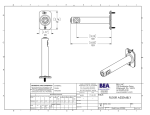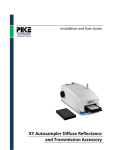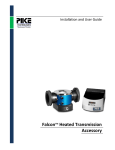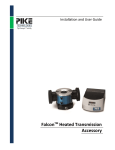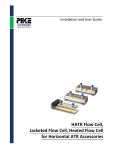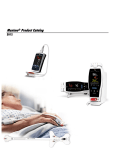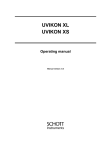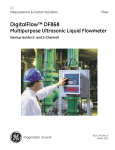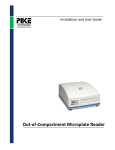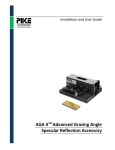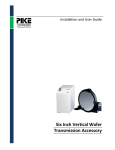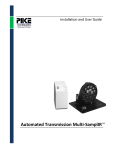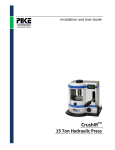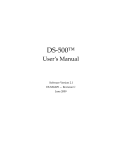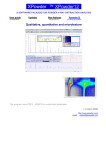Download NIR FlexIR - PIKE Technologies
Transcript
Installation and User Guide FlexIRTM NIR Fiber Optic Accessory The information in this publication is provided for reference only. All information contained in this publication is believed to be correct and complete. PIKE Technologies, Inc. shall not be liable for errors contained herein nor for incidental or consequential damages in connection with the furnishing, performance, or use of this material. All product specifications, as well as the information contained in this publication, are subject to change without notice. This publication may contain or reference information and products protected by copyrights or patents and does not convey any license under the patent rights of PIKE Technologies, Inc. nor the rights of others. PIKE Technologies, Inc. does not assume any liability arising out of any infringements of patents or other rights of third parties. This document contains confidential or proprietary information of PIKE Technologies, Inc. Neither this document nor the information herein is to be reproduced, distributed, used or disclosed, either in whole or in part, except as specifically authorized by PIKE Technologies, Inc. PIKE Technologies, Inc. makes no warranty of any kind with regard to this material including, but not limited to, the implied warranties of merchantability and fitness for a particular purpose. Copyright 1991-2014 by PIKE Technologies, Inc., Madison, WI 53719. Printed in the United States of America. All world rights reserved. No part of this publication may be stored in a retrieval system, transmitted, or reproduced in any way, including but not limited to, photocopy, photograph, magnetic or other record, without the prior written permission of PIKE Technologies, Inc. Address Comments to: PIKE Technologies, Inc. 6125 Cottonwood Drive Madison, WI 53719 Phone Fax E-mail Web Site Jan. 1, 2014 (608) 274-2721 (608) 274-0103 [email protected] www.piketech.com Contents Introduction Unpacking Your Accessory Packing List Installation Accessory Adjustment Performance Verification Solid Sampling Liquid Sampling Precautions Options 1 2 2 3 4 5 6 7 7 7 Introduction FlexIR™ Near-Infrared Fiber Optic accessory is a compact sample compartment-mounted accessory for measuring the composition of a wide variety of solid and paste materials. Using near-infrared chemometrics, qualitative product identification or quantitative analysis may be performed on pharmaceutical, nutraceutical, chemical, polymer, textile, food, agricultural or other samples. The FlexIR accessory features a high throughput, low-OH fiber optic probe with a reflectance tip and a high-speed, low-noise Indium-Gallium-Arsenide detector with optics and electronics interface. The FlexIR fits in the sample compartment of the FTIR spectrometer and connects to the detector port of the spectrometer. The window is bonded and sealed to protect the probe tip from corrosive materials and contamination. PN 350-0451000-00 P a g e |1 Unpacking Your Accessory In order for you to quickly verify receipt of your accessory, we have included a packing list. Please inspect the package carefully. Packing List User Manual PN 350-0451015 FlexIR Optical and Electronic Interface Module Quantity 1 PN 045-10XX Fiber Optics and Cable Quantity 1 Quantity 1 Probe Stand with Gold Reference Quantity 1 PN 350-0451000-00 P a g e |2 Installation Before installation, make sure the spectrometer is working in the near-infrared region without the FlexIR. Please consult the manufacturer of the FT-IR spectrometer regarding the conversion of the bench to near-infrared. This may involve replacing the beamsplitter and source to optimize for the 10,000 to 4000 cm-1 wavelength region of the IntegratIR. It is advisable to perform an alignment of the interferometer before inserting the IntegratIR into the sample compartment. Each FlexIR unit is manufactured to interface with a specific model FTIR spectrometer. Operation with a different model may require a factory conversion to be performed by PIKE Technologies. Place the Interface Module in the sample compartment of the spectrometer. The baseplate of the accessory assures the alignment of the accessory relative to the beam coming from the spectrometer. Connect the detector cable to the spectrometer. CAUTION: Make sure power to the spectrometer bench is off before plugging in the detector cable. Use the included cable to connect to the external port of the spectrometer and turn the spectrometer back on. Attach the two SMA connectors of the Fiber Optic Probe to the Interface Module. The FlexIR is ready for measurements. SMA Connectors Fiber Optic Probe Optical and Electronic Interface Probe Stand Figure 1. FlexIR NIR assembly PN 350-0451000-00 P a g e |3 Accessory Adjustment The accessory has been aligned and tested to ensure that it performs to specifications. No additional alignment is necessary. The gain of the FlexIR is set to allow the best signal-to-noise. Please check that the interferogram signal magnitude does not exceed the A/D converter required signal magnitude. This is done by placing the reflectance probe against the diffuse reference set into the bottom of the probe holder reference position (Figure 3). The interferogram signal can be reduced by using the aperture selection on the spectrometer. In the near-infrared high resolution is rarely used, thus the default aperture may be in the fully open position or any of the smaller apertures that do not significantly reduce the light level. Should a gain adjustment be necessary, which may be the case if switching between the diffuse probe tip and the liquid tip, the housing of the accessory can be removed and the gain adjusted using the potentiometer on the electronic board. This is typically a service function and PIKE Technologies should be contacted before attempting to do this adjustment. Fiber Optic Connections Detector Gain Adjust (Service Only) Figure 2. Interior view of FlexIR Electronic Interface Module PN 350-0451000-00 P a g e |4 Performance Verification With the accessory installed and the appropriate aperture set, insert the diffuse reflectance probe into the reference side of the probe stand to contact the diffuse gold reference (Figure 3). Source intensities, shape of the infrared beam, and the beam splitter characteristics vary from bench to bench. The single beam spectra may appear slightly different than shown in Figure 4. Using a 1 minute data collect time, collect a background followed immediately by a sample spectrum. The peak to peak noise around 6000 cm-1 should be equal to or less than 150 µAbs RMS. Diffuse Gold Reference Position Figure 3. Probe stand with diffuse gold reference Figure 4. Single beam energy of the FlexIR (Red), ratio of two consecutive 1 min spectra of gold reference (Blue). Noise level around 6000 cm-1 should be less than 150 µAbs RMS. PN 350-0451000-00 P a g e |5 Solid Sampling Sampling with the FlexIR is as easy as placing the probe on the sample. The probe is designed to be used with powders, plastics and other solid materials that have a flat part to contact the window on the probe. For solid samples, reproducible sample positioning has to be assured. The window at the tip of the probe is sealed using epoxy compound, thus it is relatively chemically inert and can be cleaned preferably with alcohol or with acetone for samples which are more difficult to clean. Samples for near-infrared need to be presented to the spectrometer in an optically uniform and reproducible fashion to obtain the same spectrum every time. Parameters that have significant effect on the samples are particle size and distribution, crystallinity, phase (for example, melted or solidified oils have very different spectra), compression, temperature (especially water-containing samples) and other physical or chemical differences. In all cases, the accessory is measuring the reflected light, thus transparent materials such as films produce very small signal. In certain cases, a reflective mirror can aid in returning the near-infrared light to the collecting part of the fiber. This double transmission (called transflectance) is a convenient way of measuring transparent or semi-transparent samples that have a reproducible thickness or pathlength. Figure 5. Sampling with the FlexIR through a thin plastic bag is possible due to the weak near-infrared signature of polyethylene. PN 350-0451000-00 P a g e |6 To collect a spectrum background, position the probe in the diffuse gold reference slot on the probe holder shown in Figure 3 prior to collecting the sample spectrum. Samples may be directly measured in a container using the probe. The contact between the sample and the probe should be maintained during the sample spectrum collection. Pressure on the sample should be maintained during the measurement and applied reproducibly to achieve repeatable results. Glass or plastic containers can also be used for samples, but the user must assure that the glass or plastic is uniform, reproducible and as thin as possible to position the sample surface as close to the probe tip as possible. Solids, pastes and powders can be measured. The near-infrared region is not as sensitive to residual water vapor as the mid-infrared. If the resolution is higher, the sharper water rotational-vibrational bands still are exhibited. Purging the sample compartment will also reduce this effect for increased spectral reproducibility in the water vapor regions. Liquid Sampling The Liquid Probe Tip is transflection tip used with the FlexIR Near-Infrared Fiber Optic Probe for liquid measurements. The tip is secured by threading it onto the probe end, after removal of the standard diffuse tip. To install the liquids tip, unscrew the diffuse tip first and transferring the O-ring seal between the probe body and the liquid tip. This O-ring seal is important to assure that chemicals cannot migrate into the inside of the probe. Prior to securing the liquids tip, make sure the O-ring is not damaged and that the tip is threaded on properly. Finger tightening is enough to assure proper seal. Tools are not necessary, nor recommended, to tighten the tip. Standard Tip Liquid Gap O-Ring Seal Use of Liquid Probe For measurements probe can be dipped in liquids. Please do not submerge too close to the handle, because there is no chemically-resistant seal around the handle. For background, it is best to use pure PN 350-0451000-00 P a g e |7 solvent. Otherwise, the dry cell can reflect the light differently from when the gap is filled with liquid. The small gap can be cleaned between samples with a stream of solvent (alcohol, acetone, etc.) squirted in the gap from the front and dried with a cloth or absorbent paper. Please note that water has higher surface tension and may not fill the gap just by dipping the probe due to the formation of an air bubble. To eliminate an air bubble from the gab, the probe can be held slanted with the front lip upward and the probe can also be swished in the liquid. Figure 1. Near-infrared transmission spectrum of biodiesel sample using the liquid tip. PN 350-0451000-00 P a g e |8 Liquid Tip Specifications Nominal Liquid Pathlengths Window Material Materials in Contact with Liquid 1.0 mm (two passes through 0.50 mm gap) 1.5 mm (two passes through 0.75 mm gap) 2.0 mm (two passes through 1.00 mm gap) Borosilicate glass Stainless steel, borosilicate glass, chemically resistant epoxy, Viton O-ring (Call PIKE Technologies to inquire about perfluoroelastomer O-ring) Precautions In order to provide the maximum signal in the infrared, with the minimum spectral interference, the mirrors in this accessory are thin film coated. Since the coatings are soft, care must be taken to avoid damage. Normally, these mirrors will not need cleaning since they are contained within the housing of the accessory. If they do need cleaning, they may be gently swept with a camel hair brush. Under no circumstances must the mirrors be rubbed with paper products such as “Kleenex” since this may scratch the mirror coating. Options Part Number 045-2001 045-2000 045-2002 045-2010 PN 350-0451000-00 Description Liquids Sampling Tip, 1.0 mm pathlength Liquids Sampling Tip, 1.5 mm pathlength Liquids Sampling Tip, 2.0 mm pathlength Diffuse Reflection Tip for FlexIR NIR Probe P a g e |9 6125 Cottonwood Drive · Madison, WI 53719-5120 · (608) 274-2721 (TEL) · (608) 274-0103 (FAX) [email protected] · www.piketech.com













